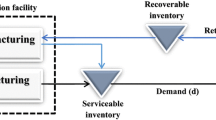Abstract
Coordination across different process stages of the supply chain is becoming more common as the information needed for this coordination is easier to obtain and share. With the availability of this information, managers are beginning to recognize that there can be benefits to scheduling processes in a coordinated fashion. Thus, finding good schedules for the entire supply chain has added importance to today’s managers. Coordination of the material as it moves from one stage to the next should lead to improved customer order lead-time performance for the whole chain and thus better customer service overall. We look at a two-stage assembly supply chain with the objective of minimizing the average customer order lead-time. Minimizing lead-time is becoming increasingly important as customers demand quicker response. But beyond this better customer service objective, minimizing lead-time is consistent with keeping inventory costs low. We introduce a number of properties of optimal solutions, results for special problem cases, and a series of lower bounds. We also provide a number of intuitive heuristics for coordinated supply chain scheduling and test them to determine their effectiveness.
Similar content being viewed by others
References
Ahmadi, R. H., & Bagchi, U. (2001). Coordinated scheduling of customer orders (Working Paper). UCLA.
Blocher, J. D., & Chhajed, D. (1996). The customer order lead time problem on parallel machines. Naval Research Logistics, 43, 629–654.
Blocher, J. D., Chhajed, D., & Leung, M. (1998). Customer order scheduling in a general job shop environment. Decision Sciences, 29, 951–981.
Chen, Z.-L., & Hall, N. G. (2004). Supply chain scheduling: assembly systems (Working Paper). University of Maryland.
Garey, M. R., Johnson, D. S., & Sethi, R. (1976). The complexity of flowshop and jobshop scheduling. Mathematics Operations Research, 1, 117–129.
Gupta, J., Ho, J. C., & van der Veen, J. A. (1997). A single machine hierarchical scheduling with customer orders and multiple job classes. Annals of Operations Research, 70, 127–143.
Hariri, A. M., & Potts, C. N. (1997). A branch and bound algorithm for the two-stage assembly scheduling problem. European Journal of Operations Research, 103, 547–556.
HBS Case (1991). Digital equipment corporation: complex order management. Harvard Business School, Case #9-690-081.
Ignall, E., & Schrage, L. (1965). Application of the branch and bound technique to solve some flowshop scheduling problems. Operations Research, 13(3), 400–412.
Julien, F. (1992). A general framework for five single machine batching models. University of Ottawa, Ontario.
Kraemer, K. L., & Dedrick, J. (2002) Dell computer: organization of a global production network. Center for Research on Information Technology and Organizations, University of California, Irvine. http://www.crito.uci.edu/GIT/publications/pdf/dell.pdf.
Lee, H., & Billington, C. (1992). Managing supply chain inventory: pitfalls and opportunities. Sloan Management Review, 33(3), 65–73.
Lee, C.-Y., Cheng, T. C. E., & Lin, B. M. T. (1993). Minimizing the makespan in the 3-machine assembly-type flowshop scheduling problem. Management Science, 39(5), 616–625.
Potts, C. N., Sevast’janov, S. V., Strusevich, V. A., Van Wassenhove, L. N., & Zwaneveld, C. M. (1995). The two-stage assembly scheduling problem: complexity and approximation. Operations Research, 43(2), 346–355.
Author information
Authors and Affiliations
Corresponding author
Rights and permissions
About this article
Cite this article
Blocher, J.D., Chhajed, D. Minimizing customer order lead-time in a two-stage assembly supply chain. Ann Oper Res 161, 25–52 (2008). https://doi.org/10.1007/s10479-007-0289-7
Received:
Accepted:
Published:
Issue Date:
DOI: https://doi.org/10.1007/s10479-007-0289-7




